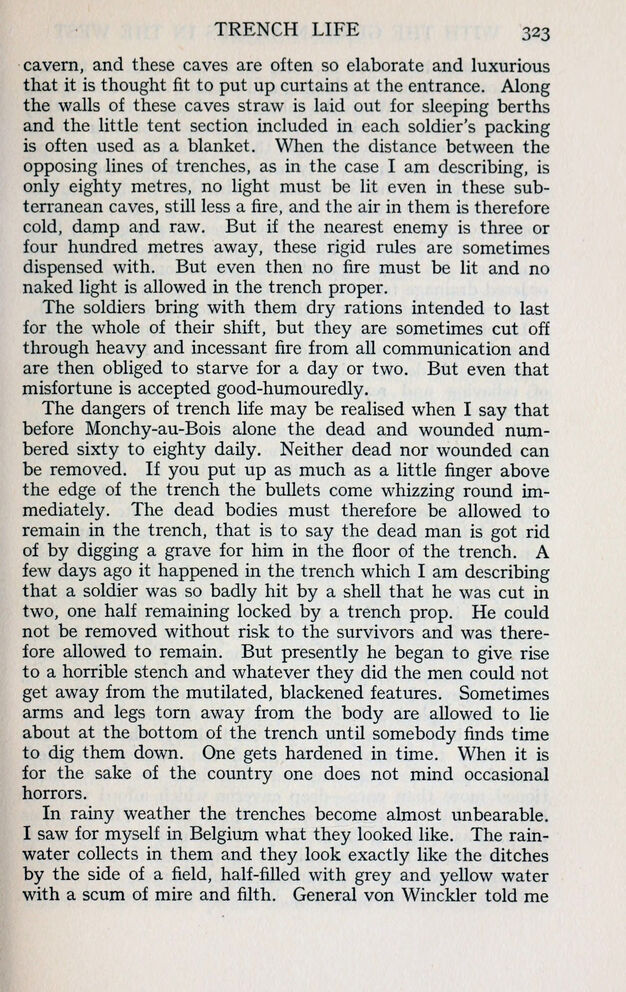
Full resolution (JPEG) - On this page / på denna sida - XX. Trench Life

<< prev. page << föreg. sida << >> nästa sida >> next page >>
Below is the raw OCR text
from the above scanned image.
Do you see an error? Proofread the page now!
Här nedan syns maskintolkade texten från faksimilbilden ovan.
Ser du något fel? Korrekturläs sidan nu!
This page has never been proofread. / Denna sida har aldrig korrekturlästs.
TRENCH LIFE 323
cavern, and these caves are often so elaborate and luxurious
that it is thought fit to put up curtains at the entrance. Along
the walls of these caves straw is laid out for sleeping berths
and the little tent section included in each soldier’s packing
is often used as a blanket. When the distance between the
opposing lines of trenches, as in the case I am describing, is
only eighty metres, no light must be lit even in these sub-
terranean caves, still less a fire, and the air in them is therefore
cold, damp and raw. But if the nearest enemy is three or
four hundred metres away, these rigid rules are sometimes
dispensed with. But even then no fire must be lit and no
naked light is allowed in the trench proper.
The soldiers bring with them dry rations intended to last
for the whole of their shift, but they are sometimes cut off
through heavy and incessant fire from all communication and
are then obliged to starve for a day or two. But even that
misfortune is accepted good-humouredly.
The dangers of trench life may be realised when I say that
before Monchy-au-Bois alone the dead and wounded num-
bered sixty to eighty daily. Neither dead nor wounded can
be removed. If you put up as much as a little finger above
the edge of the trench the bullets come whizzing round im-
mediately. The dead bodies must therefore be allowed to
remain in the trench, that is to say the dead man is got rid
of by digging a grave for him in the floor of the trench. A
few days ago it happened in the trench which I am describing
that a soldier was so badly hit by a shell that he was cut in
two, one half remaining locked by a trench prop. He could
not be removed without risk to the survivors and was there-
fore allowed to remain. But presently he began to give rise
to a horrible stench and whatever they did the men could not
get away from the mutilated, blackened features. Sometimes
arms and legs torn away from the body are allowed to lie
about at the bottom of the trench until somebody finds time
to dig them down. One gets hardened in time. When it is
for the sake of the country one does not mind occasional
horrors.
In rainy weather the trenches become almost unbearable.
I saw for myself in Belgium what they looked like. The rain-
water collects in them and they look exactly like the ditches
by the side of a field, half-filled with grey and yellow water
with a scum of mire and filth. General von Winckler told me
<< prev. page << föreg. sida << >> nästa sida >> next page >>